Acer Swift 3 (2022) Review
An affordable portable with a fast performance
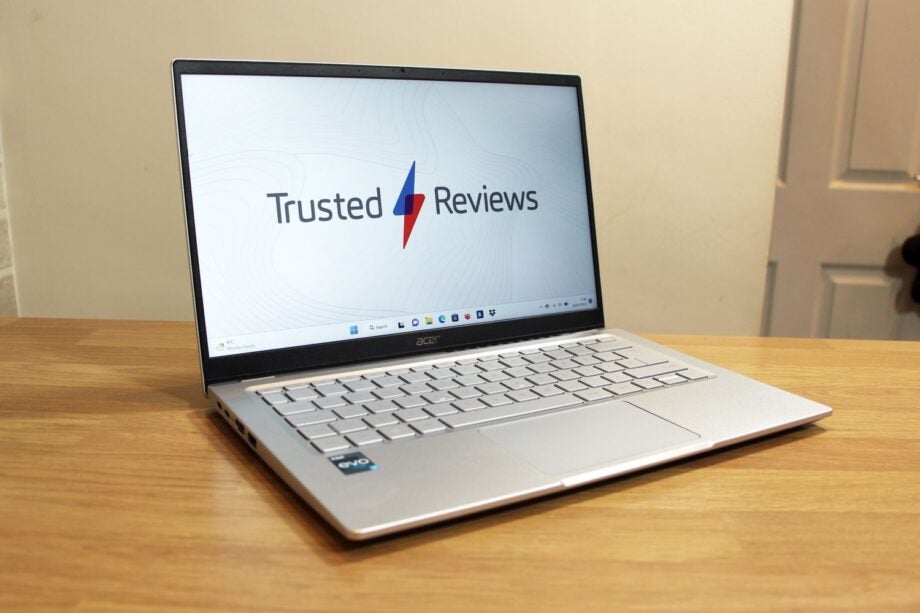
Verdict
The Acer Swift 3 is fast, affordable and decent in most departments thanks to its solid connectivity and high-resolution screen. But if you want more style, battery life or screen quality then you’ll have to find it elsewhere.
Pros
- Impressive Core i7 processor
- Smart, subtle and sturdy chassis
- High-resolution screen
- Cheaper than rivals
Cons
- Mediocre battery life
- Slimmer, better-looking rivals
- Soft keyboard and small trackpad
- Restrictive screen quality
Availability
- UKRRP: £899
- USARRP: $949
- EuropeRRP: €1299
Key Features
- An impressive Intel processorIntel’s Core i7-1260P is a mid-power processor designed for smaller laptops, and it produces a stellar performance.
- A high-resolution displayThe Swift’s 14in IPS panel has a 2560 x 1440 resolution, so it offers crisper imagery and more on-screen space than a conventional 1080p panel.
- Decent connectivity, including full-size USB portsThe inclusion of two full-size USB ports helps the Acer exceed its rivals when it comes to physical connectivity – these days, you often won’t find any of those on smaller notebooks.
Introduction
There’s no doubt that the tech market is crammed with enticing, luxurious laptops, but not everyone wants one of those high-end machines – or wants to spend that much cash. Happily, portables like the Acer Swift 3 aim to provide high-quality computing without breaking the bank.
On the outside of this rig you’ll find aluminium casing and a QHD screen that delivers more versatility than the average 1080p panel, and internally the Acer boasts a speedy Intel processor.
In the US and UK you’ll get this notebook (model number SF314-512-72NG) for $949 and £899, but in Europe the price is a little higher – at the time of writing it sat at €1299.
Still, those decent prices undercut lots of other notebooks, and they should help the Acer compete against some strong rivals, including the $1299 / £1299 / €1399 Asus Zenbook S 13 and the Dell XPS 13, which costs $1099 / £1179 / €1499 with a specification to match the Acer. Time will tell, though, if it can find its way onto our best laptop chart or our best student laptop rundown.
Design and Keyboard
- It’s a good-looking and sturdy notebook
- Decent connectivity from pairs of USB and Thunderbolt ports
- The keyboard is fine, but you’ll get more satisfying typing elsewhere
The Acer Swift 3 is a subtle, smart-looking device. The aluminium alloy base tapers to a narrow edge, and the tiny logos and lack of silly features make for a mature-looking design. And while there’s a little flex in the keyboard deck and display, the build quality is not a concern and this laptop is easily strong enough to withstand daily life.
The Acer is pretty practical, too. Each side has a full-size USB 3.2 Gen 1 port, with one always-on for charging, and the rig also has two Thunderbolt 4 ports – with one needed to charge the laptop. An HDMI 2.1 socket enables high-quality display outputs.
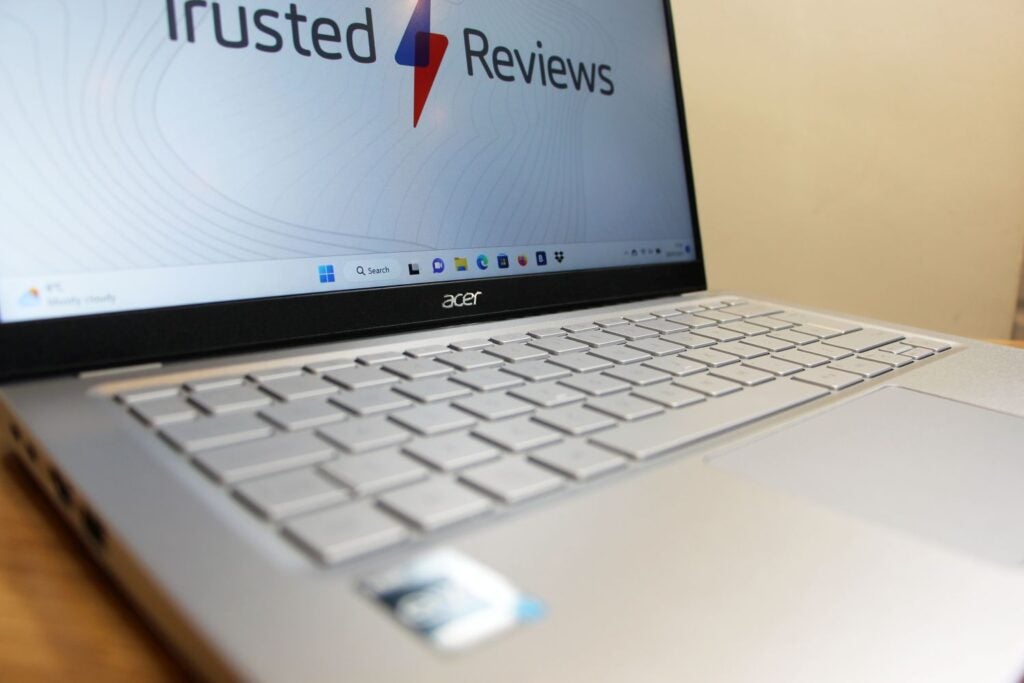
Internally, Acer’s notebook deploys dual-band Wi-Fi 6E and Bluetooth 5.2 alongside a crisp 1080p webcam. And while that webcam doesn’t have Windows Hello support or a privacy option, the power button does have a fingerprint reader for biometric login.
That’s a solid slate of connectivity features. Neither rival includes a card reader or a full-size USB port, both only have 720p webcams, and the Asus doesn’t have Thunderbolt.
Get beyond this core functionality, though, and it becomes clear that the Acer is built to a budget.
The keyboard’s buttons are a bit loud and soft, and the backlight is a little uneven. It’s fine for everyday work and use, but the Asus and Dell notebooks are firmer, faster and more satisfying. Similarly, the trackpad is small and its hollow button presses don’t inspire much confidence.
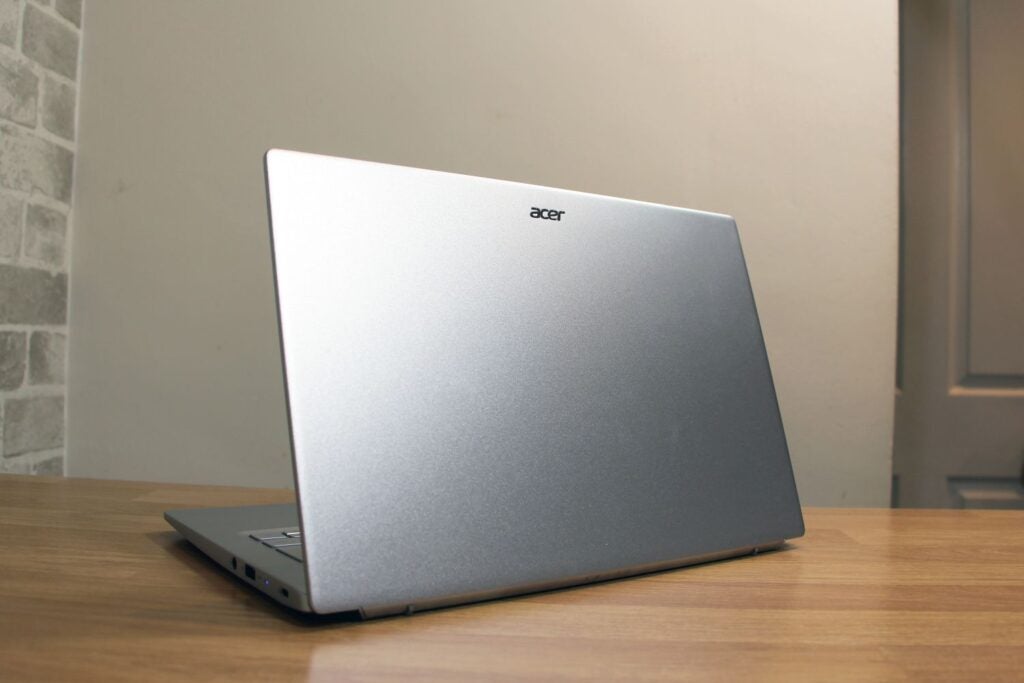
There are some underwhelming design touches elsewhere. A card reader would have been nice, and the Thunderbolt 4 ports are too close together – use one and you might block the other. On the inside, you get two M.2 connectors but the memory is soldered and so isn’t available for upgrading. There’s no wired internet.
And while the Acer’s 14-inch screen is a little bigger than the 13.3-inch panels on the Asus and Dell rigs, the Swift’s 1.25kg weight and 15.9mm-thick body mean the Acer is chunkier than those rigs. It doesn’t look as luxurious, either, thanks to its plastic screen bezels and modest aesthetic.
Screen
- A high resolution and impressive contrast ratio
- Lack of wide gamut ability means that it’s not ideal for creative tasks
- The speakers are underwhelming
That 14-inch panel has a resolution of 2560 x 1440, which is a surprising figure for an affordable laptop – it outstrips the Dell XPS, unless you want to pay more for a 4K upgrade.
That resolution means you’ve got a few more pixels to play with when it comes to tackling everyday work tasks and it makes it easier to use two windows side-by-side.
There are some pleasing aspects to the screen’s quality levels: the contrast ratio of 1619:1 is a tremendous figure for any IPS display and it’s chiefly down to a deep 0.21-nit black point. Those two factors ensure that the Acer’s panel has lashings of depth and vibrancy, so movies, TV shows and other media files always look bold and absorbing.
Elsewhere, though, things are a bit ordinary. While the Delta E of 1.68 is good, the Acer’s panel only renders 91.8% of the sRGB colour gamut and less than 70% of the Adobe RGB and DCI-P3 colour spaces. That means you’ve only got the ability for everyday workloads, media playback, and entry-level creative tasks. The display doesn’t lie flat, either.
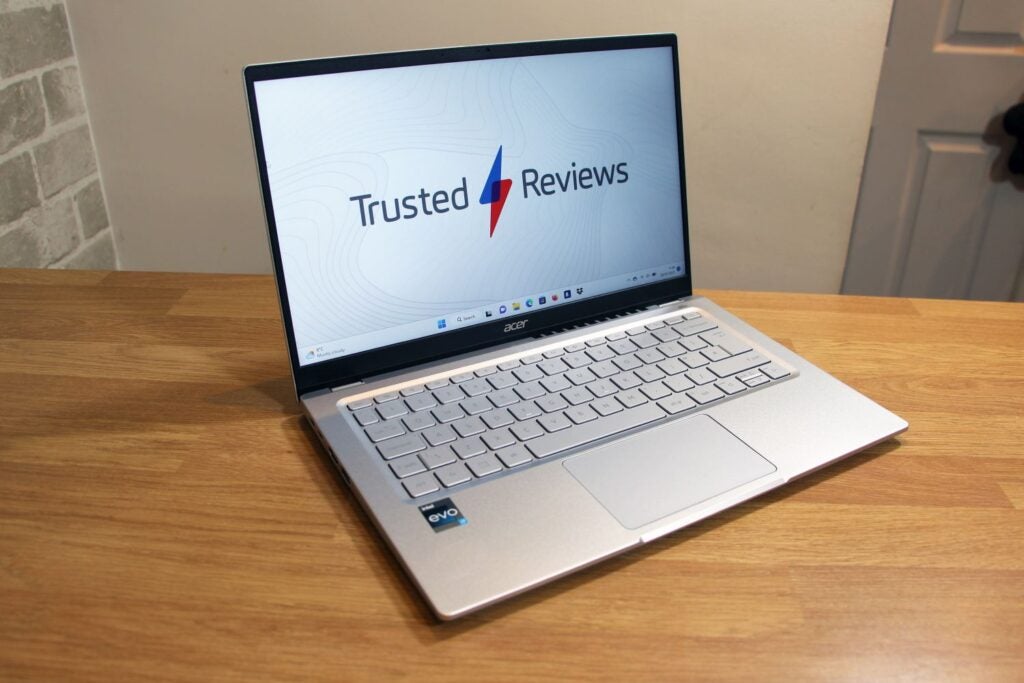
The brightness level of 340 nits is a bit restrictive, too – it’s fine for indoor use but it means you’ll struggle to see the screen properly outdoors.
Both rivals are better. The Dell, by default, includes a 1920 x 1200 IPS display – but while it can’t match the Acer for resolution, its 500-nit brightness level improves versatility and it has more accurate colours and a wider gamut than the Acer. It’s also possible to upgrade to OLED, although prices start at £1619 and the OLED panel is only available in the UK at the time of publication.
The Asus is the clear winner: by default this $1299 / £1299 / €1399 rig has a 2880 x 1800 OLED screen with superb contrast and colours thanks to near-perfect sRGB, Adobe RGB and DCI-P3 handling. Both rivals also use 16:10 aspect ratios, so they have more vertical space than the 16:9 Acer.
If you’d like a bit of OLED magic in the Acer then buyers in the US can fork out $1,199 for an upgraded version of this notebook with a 2880 x 1800 resolution and a beefier Core i7-12700H processor.
Don’t expect much from the speakers, no matter which screen you buy – they’re tinny and underwhelming, with no notable bass. Headphones or a headset will be far better.
Performance
- The Intel Core i7-1260P is stellar
- Will only handle basic games and creative workloads
- Never hot or loud, no matter the task
Intel’s Core i7-1260P has quickly become a popular laptop processing option, and that’s no wonder – this mid-power part offers versatility thanks to four Hyper-Thread performance cores, a top speed of 4.7GHz, and eight E-cores for less-demanding tasks.
Elsewhere, though, the specification is more middling. There’s 16GB of dual-channel memory but it’s DDR4 – and both rivals use faster DDR5 RAM. The 1TB SSD’s read and write speeds of 3642MB/s and 3645MB/s won’t slow you down, but the Asus and Dell notebooks both have faster storage. And there’s no proper graphics core here – just an integrated Intel Iris Xe chip.
| Acer Swift 3 (2022) | Asus ZenBook S 13 OLED | Dell XPS 13 | |
| CPU | Intel Core i7-1260P | AMD Ryzen 7 6800U | Intel Core i7-1250U |
| PC Mark 10 | 5658 | 5823 | 4559 (approx) |
| Geekbench 5 Single / Multi | 1714 / 10,297 | 1482 / 7509 | 1748 / 6524 (approx) |
| GPU | Intel Iris Xe | AMD Ryzen | Intel Iris Xe |
| 3DMark Time Spy | 1998 | 2270 | 1700 (approx) |
Despite those cutbacks, the Core i7 processor doesn’t let the side down in benchmarks. Its Geekbench single- and multi-core results of 1714 and 10297 are tremendous for this class of machine: the Asus used an AMD Ryzen 7 6800U processor and was far slower, and the Dell’s i5-1230U and i7-1250U are even further behind.
The CPU’s speed improves the Acer’s versatility. It never stuttered when running multiple apps, including a browser with loads of open tabs alongside media and office tools, and the Intel chip can handle some basic photo- and video-editing too – you won’t get that kind of power from the Asus and Dell notebooks.
When the Asus costs $1299 / £1299 / €1399 and the Dell’s Core i7 configuration starts at $1099 / £1179 / €1499, that’s impressive.
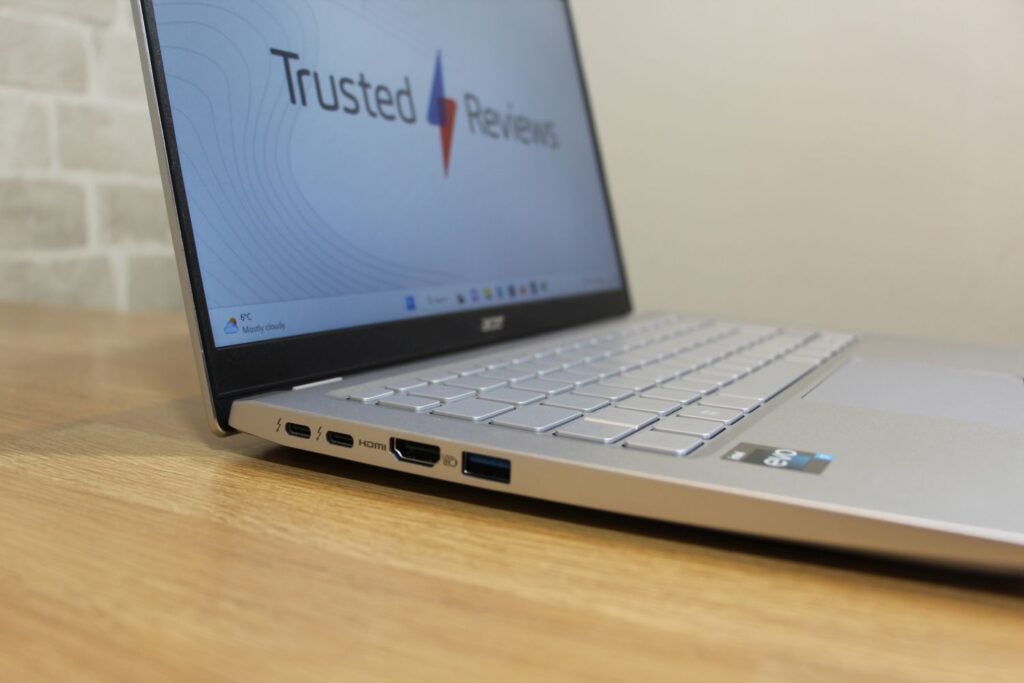
The Acer is a great thermal performer, too – even when pelting through the toughest tasks the fan noise is modest and the exterior is pretty cool. It won’t cause any issues here.
The only performance downside is that Intel Iris Xe graphics core. Its 3DMark Time Spy result of 1,998 indicates that it’ll only handle basic games and it won’t offer much assistance to creative workloads, and the Radeon core alongside the Ryzen 7 6800U in the Asus is quicker.
Better value is available if you don’t need a processor with multi-tasking and creative ability. For just $796 / £649 / €999 you’ll get a version of this rig with a Core i5-1240P and 8GB of memory. It’s a fine chip for web-browsing and office work, but that’s it.
Battery Life
- Struggles to last the whole working day
- In less-intensive tasks I easily got more than ten hours from the Swift
I extracted mixed results from the Swift’s relatively modest 56Wh power pack. With the display brightness ramped up and an everyday work benchmark loaded the Acer lasted 7hrs 42mins.
It’ll struggle to make it through a working day unless you tone down the screen brightness or don’t use much of the processor’s potential power.
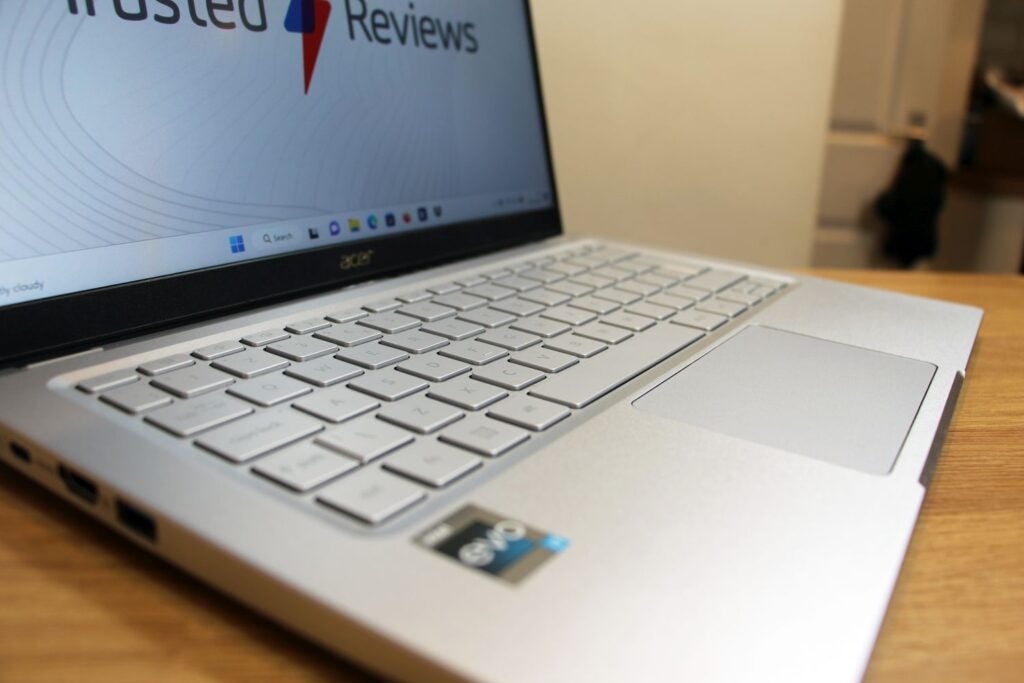
In a movie benchmark with the display brightness lowered the Swift was far better, with a result of 14hrs 15mins.
This longevity matches the Asus and outpaces the Dell, but you’re not always going to get a full day of use from the Swift before needing to plug in. Also remember that if you buy the OLED version of the machine then battery life will drop even further.
Latest deals
Should you buy it?
You want an affordable, unfussy notebook with lots of processing power:
The Acer Swift 3 is cheaper and faster than its key rivals, so it’s ideal if you want affordable power – and it’s decent in most other departments, too.
You’re looking for long-lasting luxury, or a high-quality screen:
Pricier rivals have better batteries and slicker designs, and the Acer’s display can only really handle everyday workloads.
Final Thoughts
The Acer Swift 3 deploys an Intel Core i7 processor to great effect – it’s got the power for most everyday workloads and it’s faster than rivals. Elsewhere its design, connectivity and ergonomics are all reasonable, and it’s cheaper than rivals. But while this is a good everyday machine, you’ll easily find more finesse elsewhere.
How we test
Every laptop we review goes through a series of uniform checks designed to gauge key aspects including build quality, performance, screen quality and battery life.
These include formal synthetic benchmarks and scripted tests, plus a series of real-world checks.
We used it as our main laptop for at least a week.
We tested the performance via both benchmark tests and real-world use.
We tested the screen with a colorimeter and real-world use.
FAQs
No, the Acer Swift 3 does not have a touchscreen.


